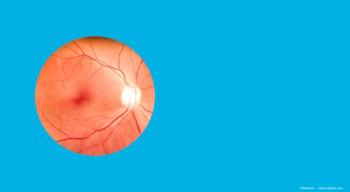
Importance of early screening for diabetic retinopathy and other diagnostic options
John Bertrand, CEO of Digital Diagnostics sits down with Managing Editor David Hutton of Ophthalmology Times to talk about the importance of early screening for diabetic retinopathy as well as other diagnostic options for National Save Your Vision month.
John Bertrand, CEO of Digital Diagnostics sits down with Managing Editor David Hutton of Ophthalmology Times to talk about the importance of early screening for diabetic retinopathy as well as other diagnostic options for National Save Your Vision month.
Video Transcript
Editor's note - This transcript has been edited for clarity.
David Hutton:
I'm David Hutton of Ophthalmology Times. March is National Save Your Vision month. To discuss some of the latest trends in the screening of diabetic retinopathy. I'm joined by Digital Diagnostics CEO John Bertrand. Ophthalmologists and clinicians should understand the importance of early screening for diabetic retinopathy. Tell us why this is important.
John Bertrand:
Well, for diabetic retinopathy, early detection of the disease and intervention leads to improvements in patient outcomes, reduction in costs, and overall reduces the burden on the health system long term. Because it's a disease that progresses over time and gets worse, as do the strength of the interventions needed, the earlier you catch it, the better. So in this case, it's really fitting we're talking about right now in National Save Your Vision Month because this is the leading cause of blindness.
David Hutton:
What diagnostic options are available for ophthalmologists to use on patients diagnosed with these diseases?
John Bertrand:
Well, for diabetic retinopathy detection, fundus cameras tend to be the most largely used devices. They're also one of the most cost effective as well. So the most physicians within the community can essentially offer this testing. So much so that as you get into some of the more recent, more innovative cameras in the fundus space, you actually see them showing up in primary care, frontline care, which is where a lot of our customer base is right now, actually. Which is interesting because it expands eyecare out into other areas you would otherwise not be able to offer to the patient. And those specialty physicians, optometrists/ophthalmologists, are essentially routed positive patients that need more either workup, or need an actual treatment. So their time is being reoriented more towards intervention wherever possible.
David Hutton:
Can you outline some of the barriers to entry when it comes to getting proper screenings?
John Bertrand:
From a patient perspective today, convenience and access are kind of 2 big things. Right now, for patients, you know they might live, if they're in a rural community, multiple hours away from an eye care physician. If you're in an urban setting, it might be closer from as the crow flies perspective, but when you add in taking off work, getting on public transit, moving to the other side of town, it's just as time consuming and onerous. So those are really on the access side 2 big things that stand in the way of patients. And for some unfortunate folks, if they have to go to a specialist that might mean an extra copay. So that's partly why we see a lot of federally qualified health centers offer our product. That saves the patient, that second copay, taking off work, while making sure the patient's positive they're still directly routed back into the eye care, kind of flow of patient care here to make sure they're getting the treatment that they need.
David Hutton:
Tell us a little bit about your company's 3 step approach to AI.
John Bertrand:
In terms of kind of key things in in the AI space that are top of mind for us. One is ethics around AI and making sure we produce algorithms without racial bias. So one of our first steps always is making sure that we source data that represents the diverse patient population we're going to be using the diagnostic algorithm on. You wouldn't want to train things with just one demographic and then fly around the world and use it somewhere else when the biomarkers do vary in the case of diabetic retinopathy, you know, based on your immutable characteristics. So that's one thing that we are really anchored on here in terms of principles. The second would be that we clinically validate all of our algorithms. So we actually go through pre registered clinical trials to clear algorithms, which is why they're FDA cleared and in use. So you actually have a strong understanding with published data that relates to that study. It's exactly how the algorithms performing, how performance on individual, diverse patient populations. So you can kind of look at your patient pop and make sure that you feel safe. And then I think the last principle would be continuous efficacy monitoring. It's something we worked with with the FDA, we're the first company to do this in the algorithm space. Where we're constantly sampling, a randomized amount of production tests. And then board certified ophthalmologist are monitoring how the algorithms performing in the field to make sure we have no diagnostic drift. It's a locked algorithm for us, that's not really possible, but we still keep an eye on things to make sure we know exactly how the algorithm performs in the field. So one's build related, one's validate related and one's ongoing monitor in terms of kind of the 3 areas we think about being principled in the AI space.
David Hutton:
What kind of feedback you're getting from ophthalmologists who are using these products?
John Bertrand:
They view it as a really kind of expansive way to expand their practice. If you're in the optometry/ophthalmology space, using our product you can use a low skilled, high school educated operator to essentially test these patients. So this allows your specialist practice top of license. So you can essentially test the patient right as they're coming in through the vitals enter the intake process, I should say. Have that diagnostic result report sitting directly in your EMR in your workflow, along with the raw fundus images and what the AI saw. So it's a way for you to essentially kind of expand test offerings, as well as help those within your practice, practice top of license.
David Hutton:
We're always wanting to know what's coming next. Is there anything you guys are working on that you can tell us about?
John Bertrand:
Yeah, we're working on quite a few things. I think AMD and glaucoma are probably the most exciting if you think about impact you can have on the patient. Diabetic retinopathy, the leading cause of blindness, AMD and glaucoma are number 1 and 2. If you have these 3 algorithms together on a single offering, you're taking care of almost all preventable blindness. You're now doing long tail of very rare cases like retinal melanoma, which you might see twice in your entire career as a practicing clinician. So that is where we're going immediately. Beyond that, though, there's a lot in the cardiac risk, nephrology, neuro function space, that we can then add on top of what we're doing from a diagnostic perspective. We know the eyes, the window into the body here, it's where we can see some of the greatest density of biomarkers without having to take a sample or do an intervention. And we just see a lot more and we can build beyond that. Our technology platform is expandable beyond the eye, of course, but we see a lot to do here in the immediate future, especially when you look at what's valuable to our customers using the product. You know what our most frequently asked, kind of what's next, priorities are from customers. It's that glaucoma, AMD and then starting to get into some of these other body system, biomarker risk scoring type algorithms.
David Hutton:
And lastly, where do you see vision diagnostics, advancing in say, the next two or three years?
John Bertrand:
Well, I think you're gonna see more AI driving diagnostics in the eye care space. This is a specialty that's very far along, compared to many others in digitizing its data, and its clinicians understanding how algorithms work. And physicians also want to be able to leverage themselves with technology to get to as many patients as they possibly can. So that's going to, I think, just result in probably second highest adoption, maybe radiology was kind of where I'm seeing things come in. And I say that more just because there's more imaging in radiology. So it's kind of hard. It's kind of an unfair comparison. But I think that's still probably where it'll land. I also think you're gonna see hardware vendors begin to design hardware with AI in mind. You know, right now, we're still in many scenarios, and there's some vendors that are ahead of their time, and others that are focused on the previous use cases where they're designing for a human being involved in the diagnostic cognitive process. When you're thinking about AI taking on more and more and doing these screening kind of tests, right, not replacing an eyecare specialist, but expanding our catchment area of patients for the screening tests. You're looking for products that are designed with AI in mind. So they're easier to use, you can get them to more people, they have lower cost of goods. Now, there's engineering challenges and trade offs with, you know, image fidelity and the number of sensors you can add. But that'll start to change over time, as you see sensor cost drop and more miniaturization happen on the hardware front. So those are kind of my two predictions, quite a bit of adoption, as well as a move towards products that incorporate AI with some of these specialized use cases to really augment what our eye care specialists are doing today in their practices.
David Hutton:
And is there any other area that would be worth noting today, maybe that I haven't brought up?
John Bertrand:
Well, there's still quite a bit you can do in the like, drug discovery space with AI and eye care. And that's something we're excited to continue to have conversations about. The ability to look at biomarkers and the impact of an intervention longitudinally over time, as well as to segment patient populations to really find where kind of precision medicine, where does this particular drug work the best. Whether that's from a demographic perspective of time, like, there's, there's a variety of ways you can continue to analyze things. So I think that's gonna continue to be an exciting space. I'm not as deep in that on the actual kind of like pharma side of things. So that's one that we're looking to get a little bit more into as the year evolves.
Newsletter
Don’t miss out—get Ophthalmology Times updates on the latest clinical advancements and expert interviews, straight to your inbox.


















































.png)


